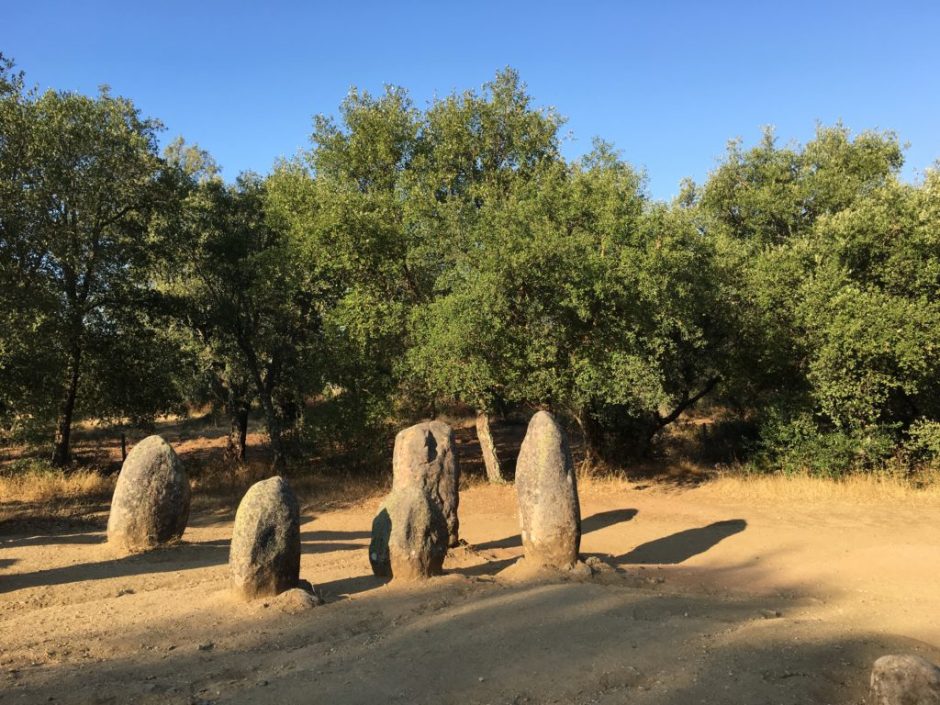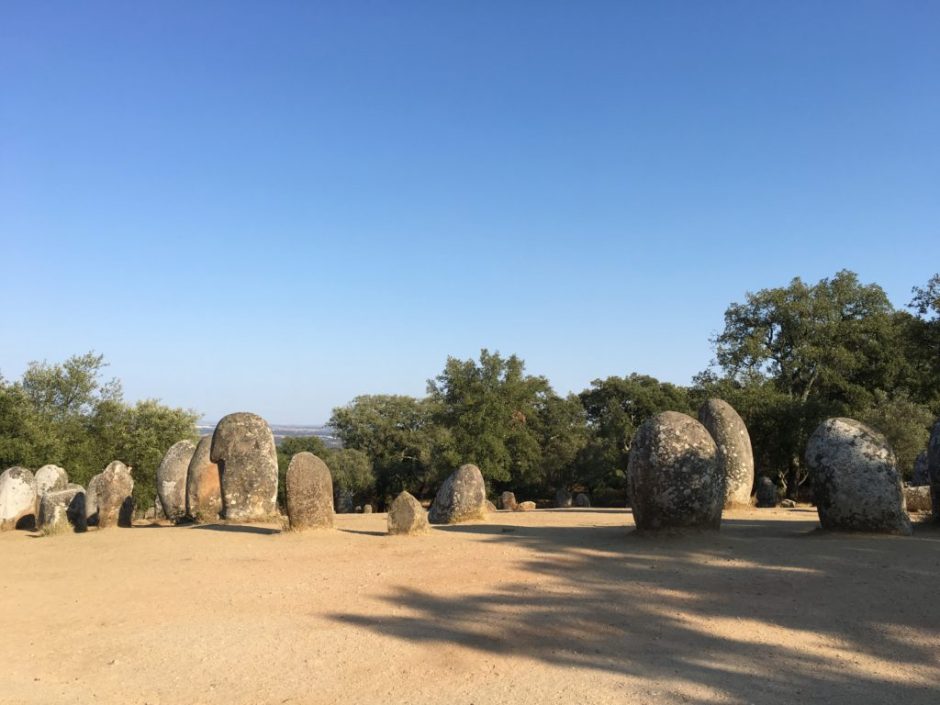The Belem district is a fascinating and historic area of Lisbon that ought to be on every traveler’s itinerary—and it appeared that it was on the Sunday we spent there! Packed with monuments, museums and many of Lisbon’s “must see” spots, it’s just about five miles from the downtown area. It’s easy to reach via bus, tram or cab. We took a 10 Euro taxi ride for the 20-minute trip from Lisbon’s city center. The tram costs less but takes nearly an hour and with so much to see, we opted to save time.
Belem was the launching point for many sea voyages during Portugal’s Age of Discovery. The Tower of Belem was the last thing sailors would see as they left port and the first site to welcome them home.

The Church of St. Jeronimos and its monastery are beautiful examples of the decorative Manueline architectural style.
Before setting off, many sailors would stop at the stunning Church of St. Jeronimos and its spectacular monastery to pray for a successful journey and a safe return. These gorgeous buildings are wonderful examples of the decorative Manueline architecture popular in Portugal in the late 1400s through 1500s.
The entry fee for the monastery is 10 Euro and worth it. It’s stunning and surprisingly peaceful in spite of the crowds. Admission is free for the church. If you plan to attend mass, be punctual. We arrived late and no amount of pleading would make the guards open the church doors for us until services were over.

Visitors to the church can see the tomb of famed Portuguese explorer Vasco da Gama and the memorial to writer Luis de Camoes.
We were directed to the end of a very, very long line. After standing around for quite some time, we realized there were no lines at the other end of the building and decided to go check it out. That’s when we found the National Archeology Museum.

Avoid the long lines at St. Jeronimos by buying a combo ticket for the Archeology Museum next door for an extra two Euro.
Here’s a tip we wished we’d known–walk right past those long lines in front of the monastery and church and make your first stop in Belem the National Archeology Museum.
Buy a combo ticket for the museum and the monastery (the monastery is actually in the same building as the museum). For an extra two Euro, or 12 Euro total, you can enjoy the museum’s terrific exhibitions and avoid the crowds. The museum is a treasure trove of Egyptian, Roman, Greek, and Moorish artifacts. After touring the galleries, you’ll go directly into the monastery from the museum without waiting on the ever-present line.

This was the first megalith we saw and it inspired us to seek out the Almendres Cromeleque, home to 95 of these fascinating stones near Evora in the Alentejo area.

The museum has a rich collection of Egyptian, Greek, Roman and Moorish art and antiquities. Be sure to visit the Room of Treasures in the museum. No photography is allowed in that area but the display of coins and jewelry from 1800 to 500 BC is impressive.

After touring the galleries in the National Archeology Museum, you’ll enter the Monastery directly without waiting on any additional lines.

This fascinating time line inside the monastery captures 500 years of world history in words and images.

In spite of the crowds, there are numerous serene spaces within the monastery perfect for quiet contemplation.
You may notice long lines around the bakery just up the street from the monastery. If you’ve been to Portland, Oregon, this may remind you of the lines around Voodoo Doughnuts. I’m always amazed by the patience people seem to have in their quest for particular baked goods, but back to Belem…
This is the place that claims to have the original and the best Pasteis de Belem. These are little custard pastries in a flaky filo- like crust. Locals say these are good, but you’ll have to decide if they’re worth waiting for. We didn’t, but we haven’t ever waited for doughnuts either. They sell Pasteis de Belem in the Starbuck’s next door without the wait, though buying them there doesn’t quite have the same cachet. You can find these delicious pastries all over the country though they’re called Pasteis de Nata (nata is cream) or Pastel de Nata, if you’re only having one, everywhere else except Belem. Try one or two and remember to add a healthy shake of cinnamon and powdered sugar on top!
If you’re hungry for a meal, we highly recommend the Enoteca de Belem (+351) 213 631 511 Travessa do Marta Pinto, 12. Located on a little alley off the main street in Belem, this is a terrific choice for lunch or dinner. It’s very small so book a table or prepare to be disappointed.
We sat at the bar since we had missed our reservation time—the museum and monastery were so fascinating we spent far longer than we had anticipated. The bar turned out to be perfect for us because in addition to a fabulous lunch, we had a great chat and learned quite a bit about Portuguese wines and history.

The perfectly prepared scallops with cauliflower puree and quail eggs were as delicious as they looked.

The freshly caught grouper was the fish of the day. Served with “clam rice,” it was an incredibly flavorful dish.

Portuguese cuisine often pairs fish and pork. The tender grilled octopus and spicy chorizo was perfection on a plate.

This classic dessert, Papo de Anjo, reminded us of an upgraded rice pudding. Comfort food at its best!
Our lunch was incredible and one of the best meals we had in Lisbon. Try the scallops to start and the grouper or cod if they have it.

When we asked for the wine list, we were handed these vintage binoculars and instructed to look around and choose whatever we were interested in from the shelves above the bar. There was a printed list, as well, but selections change regularly– thus the binoculars.

We opted for wines by the glass so we could sample several. The staff were well- versed in the wide selection available and happy to make suggestions and answer questions.
The knowledgeable staff will be glad to help you match the appropriate wines to your food selections.

Sailboats and other pleasure craft ply the waters off the embarcadero. The Hippotrip looked like Lisbon’s version of the Boston Duck Tours. Could be fun, but we didn’t try it.
Next, take a walk along the water down to the Monument to the Discoveries, which honors Prince Henry the Navigator, and was built in 1960 to commemorate the 500th anniversary of his death. Henry’s mother, Queen Filipa of Lancaster, Vasco da Gama, Magellan, King Manuel I and the poet Camoes are all depicted on the monument.

The busy waterfront is the perfect place to stroll and people watch. It’s possible to go inside the Monument to the Discoveries, which commemorates the 500th anniversary of the death of Henry the Navigator.

The Tower of Belem was the last bit of home Portuguese sailors saw as they set off to sea. It offers beautiful views but be prepared for long lines if you’d like to climb the 120 steps to the top.
Further on, you’ll see the famous Tower of Belem. It’s possible to climb 120 steps to the top of the tower for the views. Lines can be quite long. Let’s face it—there are lines for nearly everything you’ll want to see in this area so just be prepared for that. There’s an Atlas Hotel along the way with a nice terrace, perfect for an apperitivo if you’re ready for a break from touring– and the lines.

There is a lovely park near the waterfront and we happened to catch a good- sized open air market there on our visit.
On our walk back, we came upon an open air market selling everything from hand crafted ceramics, art and jewelry, to tea towels and mass-produced souvenirs. There was also a lively folk dance competition taking place in the park and we simply had to stop and watch for a while. It was delightful!

Troupe after troupe of talented folk dancers took the stage in the park. We joined the crowd to cheer them on.

Near the stage where the dancers competed, we spotted this pavilion. It was a 2012 gift from the Royal Thai Government to Portugal, celebrating 500 years of bilateral relations between the two nations.
We wished we had more time in Belem. We would like to have seen the Maritime Museum, Coaches Museum and the Ajuda Palace. Next time for sure!




































































































































































































































